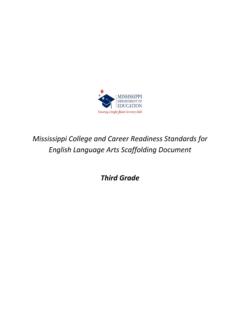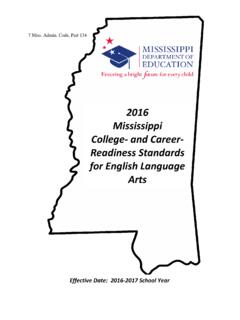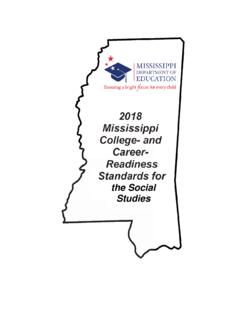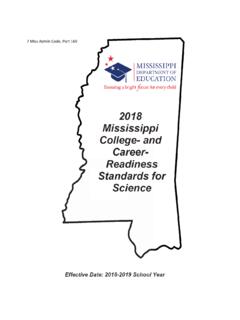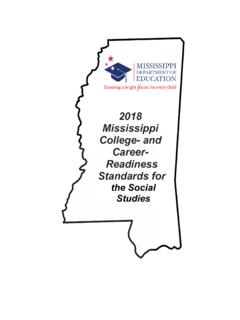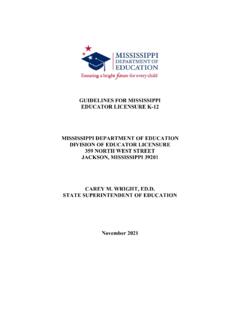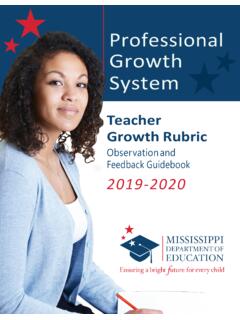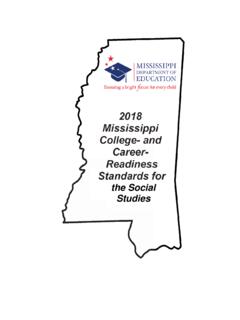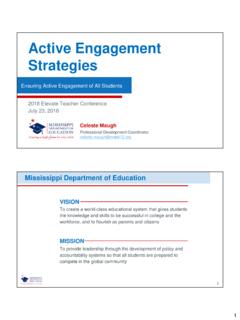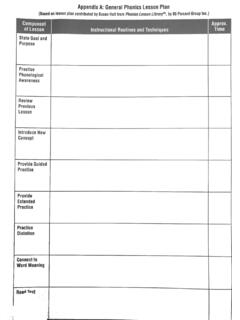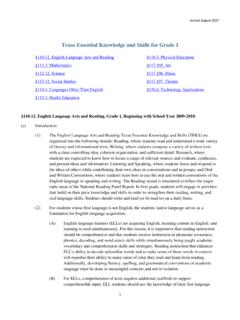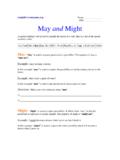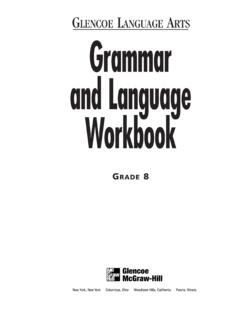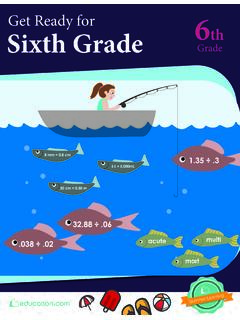Transcription of Second Grade - Mississippi Department of Education
1 Mississippi College and Career Readiness Standards for English Language Arts Scaffolding Document Second Grade College- and Career-Readiness Standards for English Language Arts Page 2 of 71-August 2016 Second Grade : Read closely to determine what the text says explicitly and make logical inferences from it; cite specific textual evidence and when writing or speaking to support conclusions drawn from the text. Ask and answer such questions as who, what, where, when, why, and how to demonstrate understanding of key details in a text. Desired Student Performance A student should know (Prerequisite Knowledge) There is a difference between a telling sentence and an asking sentence. Key words ( , who, what, when, etc.) signal a question is being asked. How to ask questions to clarify meaning and self-monitor understanding, especially when meaning is lost.
2 How to visualize key elements within the text. How to ask and answer questions before, during, and after reading. Remember key details located within the text. A student should understand (Conceptual Understanding) Growing readers ask and answer literal and inferential questions. Readers support inferential thinking based on specific evidence from the text and prior knowledge. Readers read with a question in mind. They infer answers not explicitly stated within the text. Thoughtful readers ask questions for a variety of purposes: to determine an author s style, intent, content, and format. Growing readers read closely to cite information from the text in order to ask and answer questions. A student should be able to do (Evidence of Knowledge) Provide questions and/or answers that show understanding of key details in a text, including answers to such questions as who, what, where, when, why, and how within the text.
3 Provide questions and/or answers that show understanding of key details beyond the text (inferential). Ask and answer questions about the characters, setting, and plot (beginning, middle, end, problem, and solution) of a text. Record questions and answers in a variety of formats ( , graphic organizer, sticky notes, two-column notes, jotting on text). KEY LANGUAGE/VERBS/TERMS RELATED TO THE STANDARD: prior knowledge, schema, think aloud, infer, inferential, question, visualize, read closely, reread, use text features, draw or write thinking College- and Career-Readiness Standards for English Language Arts Page 3 of 71-August 2016 Second Grade : Determine central ideas or themes of a text and analyze their development; summarize the key supporting details and ideas. Recount stories, including fables and folktales from diverse cultures, and determine their central message, lesson, or moral.
4 Desired Student Performance A student should know (Prerequisite Knowledge) How to identify the major characters, setting, problem, and solution in retelling a story. How to determine the importance of information within the text. How to utilize basic summarization strategies and generate a summary statement. How to make connections based on prior knowledge. How to utilize an organizational tool to demonstrate understanding of the central message, lesson, or moral characteristics of fables and folktales. Recount is to retell the important information in the story. A student should understand (Conceptual Understanding) Growing readers reflect on the way the author introduces the characters, describes the setting, sets up the problem, and describes how the solution is achieved. Growing readers understand how characters actions contribute to the plot throughout the course of the story.
5 The moral is the lesson contained or learned in a story. The lesson is what the characters learn in a story. The central message is the big idea the author is trying to get across. A student should be able to do (Evidence of Knowledge) After reading or listening to a story, retell the story, fable, or folktale by providing an identification and justification of the central message, lesson, or moral in a text. Read closely to synthesize key points made by the author to figure out the central message or theme. Determine the theme and describe the main character s experiences in relation to the theme through oral and written conversations. Give a summary of the important elements of the text. KEY LANGUAGE/VERBS/TERMS RELATED TO THE STANDARD: synthesize, mental images, background knowledge, recount, retell, fables, folktales, central message, lesson, moral, recount College- and Career-Readiness Standards for English Language Arts Page 4 of 71-August 2016 Second Grade : Analyze how and why individuals, events, or ideas develop and interact over the course of a text.
6 Describe how characters in a story respond to major events and challenges. Desired Student Performance A student should know (Prerequisite Knowledge) How to orally describe a character. A major event is where something important happens in the story. The setting is where and when a story takes place. How to use prior knowledge to predict what is coming next in the text. How to identify basic story elements as well as major events or challenges within a story. How to monitor thinking so that they understand when meaning is lost. A student should understand (Conceptual Understanding) Growing readers describe a character by thinking about their feelings, actions, and thoughts. Thoughtful readers analyze and describe the details that impact the major events within the story. Readers utilize critical thinking skills to draw conclusions based on textual evidence to think about how characters respond to major events and challenges.
7 A student should be able to do (Evidence of Knowledge) Identify the characters in a story. Describe how characters in a story respond to challenges utilizing text-based evidence. Describe the major events that happen in the story and tell how the characters react to changes during the major events. Provide descriptions that represent the characters thoughts, feeling, or actions based on textual evidence to complete reading activities such as a character map. KEY LANGUAGE/VERBS/TERMS RELATED TO THE STANDARD: characters, describe, major events, challenges, draw conclusions, analyze, think critically College- and Career-Readiness Standards for English Language Arts Page 5 of 71-August 2016 Second Grade : Interpret words and phrases as they are used in a text, including determining technical, connotative, and figurative meanings, and analyze how specific word choices shape meaning or tone.
8 Describe how word and phrases ( , regular beats, alliteration, rhymes, repeated lines) supply rhythm and meaning in a story, poem, or song. Desired Student Performance A student should know (Prerequisite Knowledge) How to use strategies to figure out unknown words. How to figure out words based on eight context clues ( , definition, restatement or synonym, contrast or antonym, comparison, list or series, cause and effect, example, inference). Word choice impacts meaning of text. How to identify literal and non-literal meanings of words including figurative language. Types of literary devices authors utilize such as alliteration, repetition, rhythm, and rhyme. A student should understand (Conceptual Understanding) Readers actively look for the meaning of unknown words/ phrases to clarify meaning so they can deepen their understanding of text. Authors chose language that creates powerful images in the readers mind as well as create meaning for their readers.
9 Growing readers recognize types of literary devices ( , regular beats, alliteration, rhymes, repeated lines) authors use to convey their message and make writing more appealing to the reader. A student should be able to do (Evidence of Knowledge) Demonstrate the use of context clues to determine meanings of unknown words and phrases in text. Describe how language choice impacts and creates meaning in text. Explain how rhythmic words and phrases assist the reader in gaining deeper meaning in stories, poems, or songs. Describe how or why authors use repeated lines in text to create rhythm and meaning. KEY LANGUAGE/VERBS/TERMS RELATED TO THE STANDARD: word choice, words and phrases, regular beats, alliteration, rhymes, repeated lines College- and Career-Readiness Standards for English Language Arts Page 6 of 71-August 2016 Second Grade : Analyze the structure of texts, including how specific sentences, paragraphs, and larger portions of the text ( , a section, chapter, scene, or stanza) relate to each other and the whole.
10 Describe the overall structure of a story, including describing how the beginning introduces the story and the ending concludes the action. Desired Student Performance A student should know (Prerequisite Knowledge) How to identify basic story structure elements for literary text beginning, middle, end, problem, and solution. Stories are usually told to entertain, teach a lesson, or send a message. Different types of literary text ( , poems, fables, fantasy, etc.) include a beginning, middle, and ending A student should understand (Conceptual Understanding) Authors often introduce the characters, settings, and plot in the beginning of the story. Authors usually reveal the important character(s) and the problem the character(s) has in the beginning of the story. Authors usually reveal how the character(s) solves the problem and/or responds to a challenge at the end of the story.
